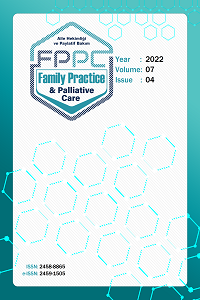Derleme
Yıl 2022,
Cilt: 7 Sayı: 4, 118 - 123, 19.10.2022
Öz
Flatfoot (pes planus) is described as a reduction or absence of the medial longitudinal arch (MLA) of the foot, with or without additional deformities of the foot and ankle. It is a very common orthopedic manifestation in infants and children and usually resolves by adolescence. Flat foot is usually flexible and painless with no functional compromise so that described as physiologic. In some rare cases flatfoot can become painful or rigid and may be a sign of pathology such as vertical talus or tarsal coalition. Although it is very common, there is no standard definition and no universally accepted classification system for pediatric flatfoot. Furthermore there are no large, prospective studies comparing the natural history of flatfoot in response to various treatments during the developmental period. Current literature suggests that it is safe and appropriate to simply observe an asymptomatic child with flatfoot. Painful flexible flatfoot may benefit from orthopedic intervention such as physical therapy, orthosis or sometimes a surgical procedure.
Keywords: Pes planus, flatfoot, infant, child, foot arch, surgery
Kaynakça
- 1. Pfeiffer M, Kotz R, Ledl T, Hauser G, Sluga M. Prevalence of flat foot in preschool-aged children. Pediatrics. 2006;118(2):634-9 https://doi.org/10.1542/peds.2005-2126.
- 2. Staheli LT. Evaluation of planovalgus foot deformities with special reference to the natural history. J Am Podiatr Med Assoc 1987;77(1):2-6 https://doi.org/10.7547/87507315-77-1-2
- 3. Staheli LT, Chew DE, Corbett M. The longitudinal arch. A survey of eight hundred and eighty-two feet in normal children and adults. J Bone Joint Surg Am 1987;69(3):426-8 https://pubmed.ncbi.nlm.nih.gov/3818704/
- 4. Huang CK, Kitaoka HB, An KN, Chao EY. Biomechanical evaluation of longitudinal arch stability. Foot Ankle 1993;14(6):353-7 https://doi.org/10.1177/107110079301400609.
- 5. Forriol F, Pascual J. Footprint analysis between three and seventeen years of age. Foot Ankle 1990;11:101-4. https://doi.org/10.1177/107110079001100208.
- 6. Sachithanandam V, Joseph B. The influence of footwear on the prevalence of flat foot. A survey of 1846 skeletally mature persons. J Bone Joint Surg Br 1995;77(1):254-7. https://pubmed.ncbi.nlm.nih.gov/7706341/
- 7. Sim-Fook L, Hodgson AR. A comparison of foot forms among the non-shoe and shoe-wearing Chinese population. J Bone Joint Surg Am 1958;40(1):1058-62. https://pubmed.ncbi.nlm.nih.gov/13587573/
- 8. Gould N, Moreland M, Alvarez R, Trevino S, Fenwick J. Development of the child’s arch. Foot Ankle 1989;9(1):241-5. https://doi.org/10.1177/107110078900900506
- 9. Wenger DR, Mauldin D, Speck G, Morgan D, Lieber RL. Corrective shoes and inserts as treatment for flexible flatfoot in infants and children. J Bone Joint Surg Am 1989;71(2):800-10. https://pubmed.ncbi.nlm.nih.gov/2663868/
Yıl 2022,
Cilt: 7 Sayı: 4, 118 - 123, 19.10.2022
Öz
Düz tabanlık (pes planus) ayak ve ayak bileğinin eşlik eden ek deformiteleri olsun ya da olmasın ayak medial longitidunal arkının düşüklüğü ya da yokluğu olarak tanımlanır. Bebeklik ve çocukluk döneminde görülen ve ergenlik döneminde sıklıkla düzelen yaygın bir ortopedik durumdur. Düz tabanlık genellikle esnek ve ağrısız olduğu ve herhangi bir fonksiyonel sıkıntı yaratmadığı için fizyolojik olarak tanımlanır. Nadir durumlarda düz tabanlık ağrılı ve sert bir ayakla karşımıza çıkabilir ve vertikal talus ya da tarsal koalisyon gibi patolojik durumların bir belirtisi olabilir. Çok sık görülüyor olmasına rağmen pediatrik Pes Planus’un standart bir tanımı ve yaygın kabul görmüş bir tanımlama sistemi yoktur. Hatta değişik tedavi yöntemlerinin idiopatik esnek düz tabanlık seyri üzerine etkisini inceleyen geniş çaplı prospektif çalışmalar da bulunmamaktadır. Şu anki veriler asemptomatik düz tabanlı çocukların sadece takip edilmesinin uygun ve güvenli olduğunu söylemektedir. Ağrılı esnek düztabanlık ise fizik tedavi, ortez ya da bazen cerrahi prosedürlerden fayda görebilir.
Anahtar Kelimeler: Pes planus, düz tabanlık, bebek, çocuk, ayak arkı, cerrahi
Anahtar Kelimeler
Kaynakça
- 1. Pfeiffer M, Kotz R, Ledl T, Hauser G, Sluga M. Prevalence of flat foot in preschool-aged children. Pediatrics. 2006;118(2):634-9 https://doi.org/10.1542/peds.2005-2126.
- 2. Staheli LT. Evaluation of planovalgus foot deformities with special reference to the natural history. J Am Podiatr Med Assoc 1987;77(1):2-6 https://doi.org/10.7547/87507315-77-1-2
- 3. Staheli LT, Chew DE, Corbett M. The longitudinal arch. A survey of eight hundred and eighty-two feet in normal children and adults. J Bone Joint Surg Am 1987;69(3):426-8 https://pubmed.ncbi.nlm.nih.gov/3818704/
- 4. Huang CK, Kitaoka HB, An KN, Chao EY. Biomechanical evaluation of longitudinal arch stability. Foot Ankle 1993;14(6):353-7 https://doi.org/10.1177/107110079301400609.
- 5. Forriol F, Pascual J. Footprint analysis between three and seventeen years of age. Foot Ankle 1990;11:101-4. https://doi.org/10.1177/107110079001100208.
- 6. Sachithanandam V, Joseph B. The influence of footwear on the prevalence of flat foot. A survey of 1846 skeletally mature persons. J Bone Joint Surg Br 1995;77(1):254-7. https://pubmed.ncbi.nlm.nih.gov/7706341/
- 7. Sim-Fook L, Hodgson AR. A comparison of foot forms among the non-shoe and shoe-wearing Chinese population. J Bone Joint Surg Am 1958;40(1):1058-62. https://pubmed.ncbi.nlm.nih.gov/13587573/
- 8. Gould N, Moreland M, Alvarez R, Trevino S, Fenwick J. Development of the child’s arch. Foot Ankle 1989;9(1):241-5. https://doi.org/10.1177/107110078900900506
- 9. Wenger DR, Mauldin D, Speck G, Morgan D, Lieber RL. Corrective shoes and inserts as treatment for flexible flatfoot in infants and children. J Bone Joint Surg Am 1989;71(2):800-10. https://pubmed.ncbi.nlm.nih.gov/2663868/
Toplam 9 adet kaynakça vardır.
Ayrıntılar
| Birincil Dil | İngilizce |
|---|---|
| Konular | Cerrahi, Çocuk Sağlığı ve Hastalıkları |
| Bölüm | Derleme Makale (Review Article) |
| Yazarlar | |
| Yayımlanma Tarihi | 19 Ekim 2022 |
| Gönderilme Tarihi | 31 Ocak 2022 |
| Kabul Tarihi | 5 Eylül 2022 |
| Yayımlandığı Sayı | Yıl 2022Cilt: 7 Sayı: 4 |


